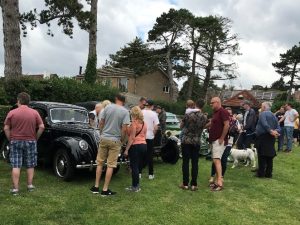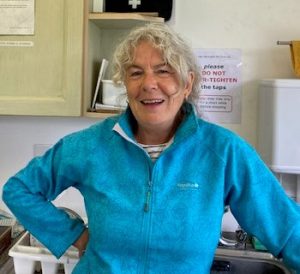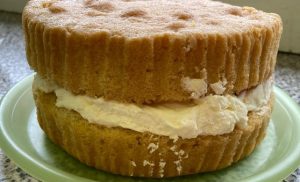THE MILL
Newsletter for Members and Friends of High Salvington Windmill October 2021
We did it!
Despite all the problems that Coronovirus threw at us, with all the lockdowns, restrictions, and delays, the mill has had a successful season this year. Read our Chairman’s report below.
Letter from the (acting) Chairman – Jeff Best
|
|
Despite the continuing pandemic, the volunteers were able to operate some open days and events this year. Once regulations permitted, we opened the mill field on scheduled open days to pre-booked family groups in June. With the delay in removing full restrictions, this carried on through July. Full open days commenced in August, with the Classic Cars Day. The Fete was held a month later than usual – on August 15th. We had downgraded it slightly to a “Fun Day” to cater for a reduction in available volunteers, and we were dealing with three major events on three consecutive open days. But despite the smaller event, it was a great success. Thank you to all the volunteers, without whom none of this would have been possible. Special mention to Lucy Brooks for managing the party booking system, Ann English (Classic Cars), Graham Carthew (“Fun Day”), Andy Campbell (Crafts Fair) and Ian Fairclough and his team of maintenance volunteers.
We have also been undertaking a major health and safety review that will result in new training being introduced for all volunteers to ensure that we meet all our legal obligations. Some tasks previously carried out by any volunteer will be restricted to trained volunteers only, and some new systems of work will be required, for example, new safety apparatus for use in sail climbing. In support, to provide access to any information a volunteer may need for the tasks we ask them to carry out, a new Wiki website has been developed and will continue being updated, with all volunteers eventually having full access.
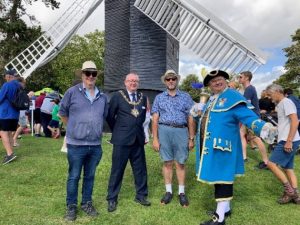
|
 Three hardy volunteers 1 Three hardy volunteers 1 |
Ian Fairclough has now stepped down as Maintenance Coordinator and our thanks go to him and to Roz Naylor-Smith who is stepping down as Group Visits Organiser. Both have carried out essential tasks for several years. Welcome to Angela Stephens who will be taking over from Roz.
We urgently need to boost both membership and volunteer numbers. On 21st January 2022 we are hoping to hold a recruitment event at St. Michael’s Church Hall in Hayling Rise, subject to the hall being available when bookings reopen later this month. We are also planning a “Founders Day” event on Saturday 14th May 2022, before the National Mills Weekend open day on 15th May. More details will be posted on our website, in due course.
Finally, I look forward to seeing all of you at the annual Bonfire Carols on 17th December.” ooOoo
|
A new toy?
The more eagle-eyed among you may have spotted the village pump installed near the little mills. It is sited outside the fence surrounding the little mills so that visitors young and old can have a go at pumping the water. Below is an article by Alex Vincent, who has made a study of village pumps throughout the land.
THE VILLAGE PUMP by Alex Vincent.
The Egyptians invented the shadoof (irrigation tool) to raise water, which dates from 2000 BC. They used a long, suspended rod with a bucket at one end and a weight at the other. The main village pump today dates from 200 BC and was invented by the Greeks. There is evidence that a pump using a plunger or piston in a barrel or cylinder existed in Greece at this period. These village pumps are hand-operated water pumps, which come in all shapes and sizes. They were built over wells and other water sources to transfer water through a pipe or spout from its source to another location or container such as a trough or bucket. Romans had wooden pumps, but most of these are now gone. Every place would have had a pump in the town square or on the village green. Towns had one in almost every street usually  at the end and several shops had one in their yard. Some were in back gardens or in homes. As well as obtaining water from streams, ponds, and wells, this was the only way, which people used to get their water before mains came. Pumps were used in farms and for cattle and horses along old trackways. They had a trough below them. The main reasons for the decline in use of village pumps were the cholera epidemics of the 1850s. The most famous case was the Broad Street pump in Soho, London. A cholera epidemic occurred in Soho in 1854 and the pump in Broad Street (now Broadwick Street) was taken out of action. Dr John Snow took the handle off the pump – an action that halted the cholera. A replica pump stands on the site outside the John Snow pub. There is an information board in the pub.
at the end and several shops had one in their yard. Some were in back gardens or in homes. As well as obtaining water from streams, ponds, and wells, this was the only way, which people used to get their water before mains came. Pumps were used in farms and for cattle and horses along old trackways. They had a trough below them. The main reasons for the decline in use of village pumps were the cholera epidemics of the 1850s. The most famous case was the Broad Street pump in Soho, London. A cholera epidemic occurred in Soho in 1854 and the pump in Broad Street (now Broadwick Street) was taken out of action. Dr John Snow took the handle off the pump – an action that halted the cholera. A replica pump stands on the site outside the John Snow pub. There is an information board in the pub.
The vast majority of the village pumps in Britain today are cast iron pumps dating to the 19th century. Some of the village pumps are in their original position, but a number are not. A lot of them were bought as a collector’s item and some are modern, purchased from garden centres. Many are still to be seen today on village greens, under shelters, over wells, in streets, gardens and outside pubs. The village pump here at High Salvington Windmill came from a house in West Hill. This house was once part of a farm owned by A C Jackson. The pump is a ‘lift and pull’ pump, mounted over an old tank and on the farm. Water came off roofs and buildings and fed into the tank. There is also a well in the garden. A story goes that when horses were used to bring grain to the mill, they were taken to the pump for a drink. The village pump is now restored and working.
| Behind the scenes – the Board members
The Board of the High Salvington Mill Trust meets every quarter.
Non-board members
|
| Card Payments
This season saw us able to take credit/debit card payments at the gate and in the tea room. The pandemic seems to have accelerated a cashless society, and we were surprised by how many people turned up without a single penny in their pockets. Unfortunately, we couldn’t extend the facility to the games and stalls for the fete, but fortunately, people brought cash with them. The app proved to be easy to use, and several of us have now trained in its use. If you prefer to pay your membership dues by card, please contact our Treasurer, Hazel Marsden on 01903 264409 or 07708 601116. Or fill in the form on page 5 and post to our membership secretary.
|
Follow us on Facebook. Just look for High Salvington Windmill and “like” our page to see news about the mill and the planned events throughout the year.
Organised group visits
The season started slowly, and we were not quite as busy with young visitors as we would have liked – the schools and youth clubs finding it too difficult to organise trips under regulations. But we welcomed several groups for a tour of the windmill.
These included a local pack of Brownies, the Fleet Air Arm, a group from Horsham U3A, and a Mindfulness practitioner for new parents, who simply wanted to use our lovely setting.
 Members of the Fleet Air Arm Members of the Fleet Air Arm |
Each time, guides volunteered to attend and show our visitors around the mill and serve them with delicious cakes made by Mel Wickett. Every single visitor was enormously appreciative of the beautiful condition of the windmill, and the detailed explanations given by the guides. A big thank you to everyone involved in organising these tours. Roz Naylor-Smith will be handing over her role to Angela Stephens in 2022, and we look forward to many more visits next year. These visits add a fair bit to our coffers and are very well worthwhile, both financially, and because they spread the word about High Salvington Windmill.
| Maintenance report – Ian Fairclough
There have been no major projects undertaken since the last Newsletter. So, with the mill and the site buildings and structures in fine fettle, attention turned to sprucing up the picket fences and benches which have all been painted. We also acquired another bench that was donated by a local resident which one of our new volunteers refurbished. The whole site was now ready for visitors who returned in June. The installation of the vintage pump has been completed and is now operational to the delight of our young (and not so young!) visitors who have enjoyed trying it out on our open days. Other small works that have taken place or are in hand include: · Additional lighting installed in the roundhouse · Fete trestles and tables have been repaired where necessary · Granary window which was rotten has been replaced and just requires painting Scheduled maintenance has continued to ensure all the mills and the grounds are in tip-top condition.
|
| Home-made cakes are top class and delicious
This season our cakes have been crafted by Mel Wickett (shown below), Albert Pardo, and Frankie Bridges. The proof of their deliciousness is that they were all sold out! What further proof is needed? Thanks to all our cake-makers, and to Mel who organises the kitchen supplies so well.
|
Craft day
The craft fair was the last event of the season and was a huge success. The sunny weather brought out the visitors and the stallholders enjoyed a very productive afternoon. The stalls ranged from cards to crafted gifts,  from woollen toys to wooden boxes. Visitors arrived throughout the afternoon. A huge thank you to Andy Campbell who organised the event, and to all the volunteers to helped make it a success. from woollen toys to wooden boxes. Visitors arrived throughout the afternoon. A huge thank you to Andy Campbell who organised the event, and to all the volunteers to helped make it a success.
One stallholder commented how much she looked forward to the craft fair at the windmill. “It’s such a lovely setting, and the weather is usually good. I love it.” ooOoo |
Running the booking system for our controlled numbers day (June/July)
With strict restrictions imposed by the Government still in place at the beginning of the season, we were unable to open at our usual season start of April. Behind the scenes, however, we were making plans. Guided by the terms of the PM’s infamous “road map” we decided to hold the volunteers’ coffee morning in late May. Many volunteers enjoyed seeing one another for the first time for over a year and the team explained the changes that had occurred in the meantime. The Board had decided to open the gates in June to a limited number of parties.
At first, this was restricted to members of the Trust only, but take-up was slow, so I decided to cast the net a little wider via Facebook groups. I had devised an online booking system via Eventbrite which allowed me to keep control of who would be coming and which part of the afternoon. I limited slots to an hour each, so we had the potential, on our first open day, to welcome nine groups in total. It went so well that we decided to increase the number of groups to fifteen over the afternoon.
The Government then delayed the easing of restrictions by a month, so we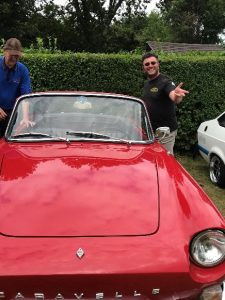 extended the scheme into July, for two further Sundays and with even more groups allowed – all distanced throughout the field, and all wearing masks when inside the mill. The results were good, and by this time we were showing people round the mill in very small family parties. However, one Sunday was affected by rain, and another by “pinging”. The no-shows were made up by passers-by asking to come in even though they hadn’t booked. It all worked out in the end, and all the volunteers on duty were thrilled to see the field busy again. We dropped the booking system for our first major event – the classic car day where we welcomed visitors in their hundreds. The picture shows one very happy exhibitor. Lucy Brooks, Board member
extended the scheme into July, for two further Sundays and with even more groups allowed – all distanced throughout the field, and all wearing masks when inside the mill. The results were good, and by this time we were showing people round the mill in very small family parties. However, one Sunday was affected by rain, and another by “pinging”. The no-shows were made up by passers-by asking to come in even though they hadn’t booked. It all worked out in the end, and all the volunteers on duty were thrilled to see the field busy again. We dropped the booking system for our first major event – the classic car day where we welcomed visitors in their hundreds. The picture shows one very happy exhibitor. Lucy Brooks, Board member
Feeding the World: Medieval Mills and Milling (from the Mills Archive)
It is clear that by the time of the Norman Conquest mills were regarded as important manorial assets. No manor was properly equipped unless it had a mill. This is demonstrated by the 6,000 plus recorded in Domesday Book, the result of the survey undertaken in 1086 (High Salvington/Durrington is not mentioned in that early survey). Considering the number of mills recorded it is perhaps surprising that the remains of few medieval watermills have been found through excavation.
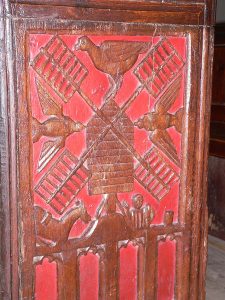 The earliest written references which specifically mention windmills date from the 1180s. In a well-documented case of 1191 Abbot Samson of Bury St Edmunds ordered the destruction of a windmill which had been built on glebe land without his permission by Herbert the dean. By the early 14th century windmills had also appeared in the north-west, at Upton-in-Widnes, Lancashire and Haulton, Cheshire, for example. While it has been suggested that windmills were built by manorial lords to supplement rather than supplant watermills, in some areas where the water supply was intermittent or the topography less favourable to providing a good fall of water, windmills became a common sight in the late medieval landscape.
The earliest written references which specifically mention windmills date from the 1180s. In a well-documented case of 1191 Abbot Samson of Bury St Edmunds ordered the destruction of a windmill which had been built on glebe land without his permission by Herbert the dean. By the early 14th century windmills had also appeared in the north-west, at Upton-in-Widnes, Lancashire and Haulton, Cheshire, for example. While it has been suggested that windmills were built by manorial lords to supplement rather than supplant watermills, in some areas where the water supply was intermittent or the topography less favourable to providing a good fall of water, windmills became a common sight in the late medieval landscape.
The earliest windmills were timber-built post mills, the whole body (sometimes called the buck) of the mill, which contained the millstones and gearing, being turned to face the sails into the wind on the top of a massive central post. For increased stability, the timbers that supported the post were often buried in the raised mound; the remains of such substructures have been found at a number of sites including Sandon Mount, Hertfordshire and near Bridgwater, Somerset.
The illustration on the left is from a church in Bishop’s Lydeard, Somerset, showing part of the trestle buried in the mound. Next to the mill is the miller with a measure for taking is toll and his packhorse.
Abridged version. You can read the full article at the Mills Archive.
A medieval mill similar to that illustrated preceded ours, which dates from 1756. There are mentions in old maps and church records to provide evidence of this.
Volunteer Drive
The Board is planning a volunteer drive in January 2022. There will be a presentation at St, Michael’s Parish Hall. Please watch out for details of this.
The shop
Visitors, especially children, love to purchase a souvenir from the shop. Pocket money priced gifts to take home are very popular, as are the windmills – a favourite with the children. The shop is stocked and organised by Roger and Kate Osborn.

Membership
High Salvington Windmill currently has 201 members (ten honorary) and would love there to be more.
Membership is excellent value at £4 per year for single member, £7 per year for dual membership, and just £40 for life membership.
A Membership form can be found below, with subscriptions payable by cash, cheque or Standing Order. As well as entitling members to attend all open days and events free of charge on presentation of your membership card, you also receive two newsletters a year, as well as being able to attend the Trust Annual General Meeting.
With Christmas approaching, a membership for family or friends would make a unique present, whilst also providing us with valuable support.
Although this last year has seen fewer events and open days than we would have liked, we very much look forward to being able to have a full programme next year.
Anyone interested in becoming a member and supporting us will be granted membership through until March 2023. If you have any questions or need more information, please email Paul Minter on membership@highsalvingtonmilltrust.co.uk.
Captain Paul B Minter RFA (Rtd), Membership Secretary
SUBSCRIPTION TO THE HIGH SALVINGTON MILL TRUST LTD
Annual membership per person £ 4.00 o
per dual couple £ 7.00 o
Life membership per person £40.00 o
I/we enclose CASH/CHEQUE payable to HIGH SALVINGTON MILL TRUST LTD
NAME: ______________________________________________________________________________
ADDRESS: ___________________________________________________________________________
Post Code_________________
Signed _____________________ Date ___________________ email: _____________________________
Send to: Membership secretary, 69 Hayling Rise, High Salvington, Worthing, BN13 3AG
email: membership@highsalvingtonmilltrust.co.uk
Data Protection: If you object to your name and address being kept on computer, please raise the matter with the membership secretary.
Registered in England Company no. 4199780 Registered office: 12 Furzeholme, Worthing BN13 3BS
‘The Mill’ is edited by Lucy Brooks. 01903 691945. lucindafbrooks@outlook.com
